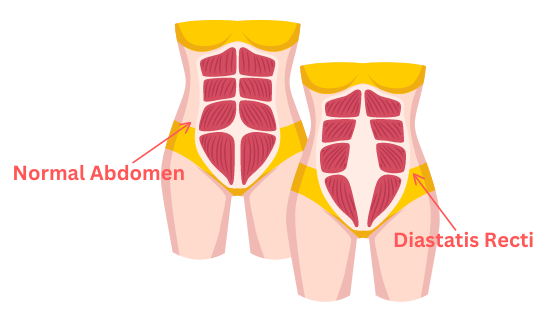Diastasis Recti is a term that may sound unfamiliar to many, but its effects are experienced by a significant number of women. And particularly those who’ve gone through childbirth.
At our W5Physio, our women’s health expert, Vicky, specialises in women’s issues like Diastasis Recti. So, let’s delve into understanding what it is, its causes, symptoms, and how it can be diagnosed.
What is Diastasis Recti?
Diastasis Recti is a condition where the two large parallel bands of muscles that meet in the middle of the abdomen (stomach) separate. This separation occurs due to the stretching of the linea alba, a connective collagen sheath created by the right and left rectus abdominis.
It can cause a bulge or “pooch” in your belly, which becomes more noticeable when your abdominal muscles are tense, such as when you sit up from a lying down position.

Causes of Diastasis Recti
While Diastasis Recti is most associated with pregnancy, it can affect anyone, including new-born babies and men. In pregnant women, the growing uterus pushes against the abdominal wall, causing the muscles to separate and the linea alba to thin out.
Other factors that can contribute to this condition include:
- Multiple pregnancies
- Carrying heavy weights improperly
- Performing incorrect exercise moves
- Ageing
- Significant weight changes
Symptoms of Diastasis Recti
The most noticeable symptom of Diastasis Recti is a bulging tummy. However, other signs can include:
- Lower back pain
- Poor posture
- Constipation
- Bloating
- Difficulty in performing routine tasks
It’s important to note that Diastasis Recti is not just a cosmetic issue. It can lead to a weakened core, impacting balance and stability, and in some cases can contribute to continence issues and pelvic organ prolapse.
Diagnosing Diastasis Recti
Diastasis Recti can be diagnosed through a simple physical examination by a healthcare professional or a physiotherapist. They’ll measure the distance between your abdominal muscles at rest and during muscle contraction. An ultrasound is sometimes needed.
The role of physiotherapy in healing Diastasis Recti
Physiotherapy plays a vital role in healing Diastasis Recti. A specialised physio, like Vicky, can provide a comprehensive treatment plan which typically includes:
- Education: Understanding the condition, its causes, and effects is the first step towards recovery. A physiotherapist educates patients on safe ways to move and lift, which helps prevent worsening the condition.
- Exercise Program: Specific exercises are designed to strengthen the deep abdominal muscles and improve core stability. These exercises are safe and effective, focusing on tensioning the abs rather than pushing them out.
- Manual Therapy: This may include soft tissue work and mobilisations to help improve the flexibility and alignment of the abdominal muscles, fascia and connective tissue.
- Lifestyle Modifications: Guidance on maintaining a healthy weight, proper nutrition, and postural awareness can also aid in recovery.
Physiotherapy not only helps in healing Diastasis Recti but also empowers women to regain control over their bodies and improve their overall quality of life.
Ultimately, Diastasis Recti is a common but often overlooked condition. Awareness is the first step towards recovery. If you suspect you may have Diastasis Recti, it’s essential to seek professional help.
At W5Physio, we specialise in women’s physiotherapy and provide personalised treatment plans for conditions like Diastasis Recti. Get in touch with us today to see how we can help you. Or if you’re ready to book an appointment, please do so here.






